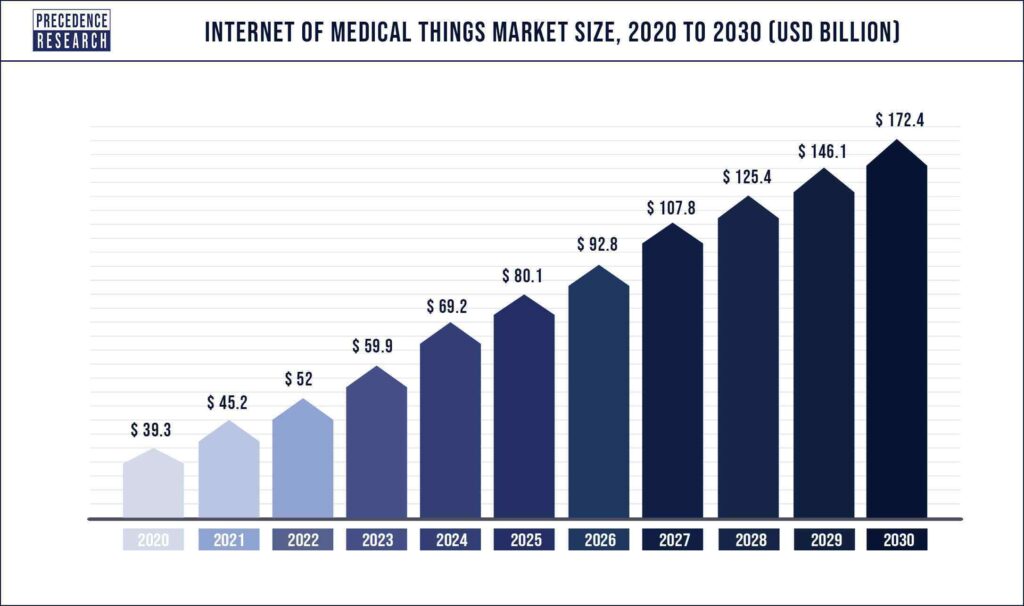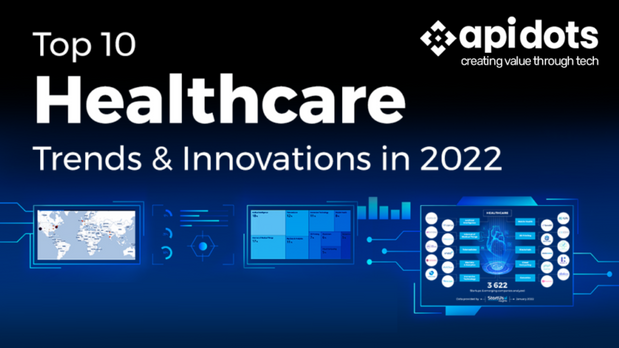Healthcare Technology is one of the most important sectors in the world. It touches lives and is a major driving force in the economies of most countries.
The major trends affecting healthcare have been undergoing a lot of changes in recent times, and this trend is only going to continue in the coming years. Healthcare technology has been changing rapidly over the past few years, and we can expect it to change even more in the future.

In this article, we will look at 10 major trends that are likely to shape healthcare technology over the next few years.
But first, let’s understand the basic concepts of trends that affect healthcare technology.
What Are the Trends in Healthcare Technology?
One of the most important and fastest-growing sectors is healthcare.
It is one of the most dynamic and creative fields because of the ongoing need to find better ways of doing things and raise the bar for quality, availability, and cost.
Technology isn’t being used as much for highly specialized treatments anymore. Instead, it’s being used more and more to help with primary and preventive care, like with wearable devices that track patients’ data remotely.
In the last few years, businesses in the healthcare sector have become more digital in order to keep up with the times. This has made technology-based healthcare solutions much more flexible.
In the future, a number of new and existing technologies will be good for the healthcare industry. Artificial intelligence, machine learning, virtual reality, augmented reality, and wearable technology will all become important tools for healthcare providers and organizations to work more efficiently.
Discover the most important trends affecting healthcare by reading on.
10 Major Trends Affecting Healthcare Technology in 2023
1. Big Data and Predictive Analytics
Big data in healthcare is likely to be the most important trend affecting the healthcare industry.
Rapid digitization permits the collection of valuable healthcare data. Wearable technology has advanced sufficiently to record continuous data at a reasonable price.
Finally, interoperable systems and new legislation have enabled the sharing of this data for predictive analytics purposes.
The use cases during the epidemic demonstrated the importance of big data in healthcare. The most obvious application was to forecast price spikes. In addition, researchers employed contact tracing technology to detect and contain epidemics.
Big data has also helped make vaccination programs better by helping to find high-risk groups based on a number of factors.
There is no way that healthcare will abandon the use of big data. This also applies to its corporate operations. Business intelligence and analytics can yield returns that justify any expenditure.
Patients now have the right to share their data, which healthcare providers can use to learn more from clinical, financial, and operational data and improve the quality of care for their patients.
2. Internet of Medical Things (IoMT)
According to Precedence Research, the global market for the internet of medical things (IoMT) reached $39.3 billion in the year 2020 and is projected to reach $172.4 billion by the year 2030.

In the development of healthcare information technology, wearables and trackers play a significant role. Their main advantage is that they give clinicians valuable, up-to-date information about patients’ health conditions that is available in real-time.
The patient’s awareness can change significantly thanks to it. People can make changes along the way and get real-time information about how they act every day thanks to trackers.
Prizes can be used to get people to live healthier lives if the device has some “gamification” features.
As a result, technology has a significant influence and enriches a sensible urge to maintain good behavior with pure enjoyment.
Doctors now have a greater ability than ever to actively participate in their patient’s care and receive reminders when it’s their turn. This new technology in health care gives a lot of information about sleep patterns, eating habits, the average amount of exercise, and other things.
With this knowledge, medical professionals may better track the course of their patient’s treatments and develop coaching programs that are more realistic.
3. Customized Mobile Apps
Currently, there are 5.5 billion smartphone users worldwide. Each of those users used their device for an average of four hours each day, with the majority of that time being spent on an app. All of this is occurring as desktop internet usage continues to decline.
At this moment, developing an iOS or Android mobile app is essential for business success. Customers are accustomed to the frictionless experience that a mobile app provides. There is no exception in the healthcare industry.
In fact, it makes sense to use a well-liked platform like this to interact with people in a field where efficient communication is so important. With integrated EHR/EMR systems, a special mobile app could become the most important way for doctors and patients to talk to each other.
A mobile app’s data that a healthcare provider can access with consent can be used in a variety of ways to enhance patient care. Additionally, teleconsultations and e-prescriptions can be offered using mobile apps.
4. Augmented reality (AR) and virtual reality (VR)
VR and AR are important parts of the latest trends in healthcare technology. Surgery training is the most obvious example. VR training allows medical professionals to practice and upgrade their skills without having to be present at a hospital.
During the pandemic, Virti, a company based in the UK, worked with the NHS to train people on the front lines. There was an urgent need for more people to work in intensive care units, and they had to be trained quickly on how to use PPE, get around an intensive care ward, use ventilators, and even talk to patients and their families.
Studies show VR training in healthcare reduces “skill fade” by 52% and boosts retention by up to 75%, surpassing traditional methods that only enhance retention by 10%.
VR apps can also be used to help take care of people.
For example, VR software and hardware can be used in exercise rehabilitation to help people get better faster.
Virtual reality and augmented reality quickly gained popularity due to their versatile applications. It makes good business sense for a precise industry like healthcare to invest in it to get better results.
5. Cloud Computing
Cloud computing in healthcare cuts down on capital and operating costs by making storage available on demand. It makes the industry work better and saves money at the same time.
Cloud computing makes it easy to share medical records, automate back-end tasks, and even make telehealth apps and keep them running.
The business of cloud computing in healthcare is expected to grow from USD 28.1 billion in 2020 to USD 64.7 billion in 2025.
Using EMRs stored in the cloud, cloud computing makes it possible to use powerful analytics to create more personalized care plans for patients.
6. Blockchain
Every time a linked device participates in a transaction of any kind, the blockchain system will produce identical blocks. When one computer reads, changes, shares, or processes data, it creates a block on all devices to store the data locally.
From 2021 to 2028, the worldwide healthcare blockchain technology market is anticipated to increase at a compound annual growth rate of 21.70 percent.
The inability to securely communicate and access sensitive patient data has had a significant negative impact on the medical sector.
Blockchain, on the other hand, will be very open and flexible while still keeping the highest security standards for true interoperability.
7. Nanomedicine
To put it simply, nanomedicine is one of the most exciting new areas of medicine. Nanomedicine is extremely useful for target drug injection and cancer treatment.
Organizations employ Nanopill cameras to examine the interior components of the body. Nanotechnology will become increasingly important in healthcare in the next few years.
By 2024, experts expect that the nanomedicine market will grow to approximately $125 billion.
8. Bioprinting
The healthcare field has been using 3D printing for a long time. In the future, people will use it in various ways beyond surgery.
Here are some of the benefits of bioprinting:-
- It makes it easier to do surgeries that are hard to do
- It takes very little time to make
- Trainers need more time to get ready
- For external implants like artificial legs, this method gives you more options than any other method
- Cost-effective
9. Wearable Technology and Sensors
The use of wearable technology in healthcare could be a way to make sure that everyone gets help with their healthcare. Healthcare professionals commonly use wearable technology in various ways to monitor patient health and improve medical care:
- Wearable devices for managing a number of health conditions.
- Preventive care for seniors and people in intensive care units.
- Give patients in care homes or remote areas quality remote care, and more.
In the end, wearable healthcare technology has filled in the gaps with useful services.
10. Robotics
Robotics, one of the major trends affecting healthcare technology, comes next. Here are some typical applications of robotics in the healthcare sector:
- Assistive and surgical robots to aid patients and medical personnel.
- Robotic companions that effectively manage your day-to-day health.
- Robots that are capable of disinfection are essential in pandemic scenarios.
- Self-help robots help patients keep track of and manage their medical issues.
Exoskeleton robots effectively provide surgical assistance and aid individuals with physical injuries, particularly those with spinal cord injuries.
Summing Up
Do you want to catch one of the health tech trends on this list?
Allow API DOTS to be your companion on this journey!
Examine our healthcare software solutions and select the one that best meets your organization’s requirements.
We at API DOTS know what’s going on in the healthcare industry. We know how to make IT products for healthcare that last a very long time.
Our team is ready to put all of their passion and knowledge into making software that fits your needs.
Start saving money, accessing top talent, receiving expert advice, scaling up for growth, beginning quickly, and staying in touch with the API DOTS team by sending us a message.

















